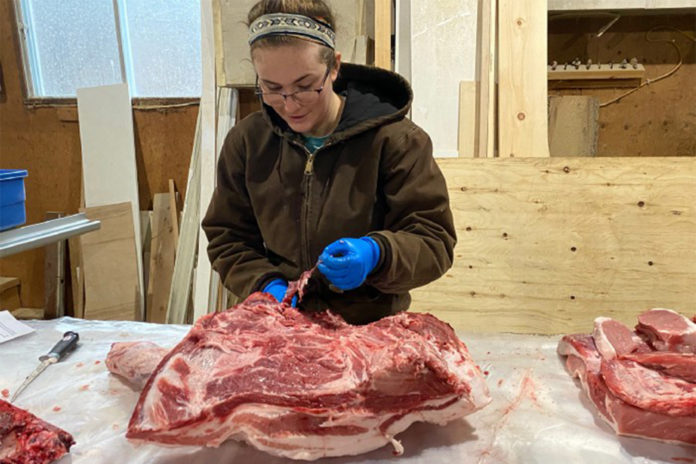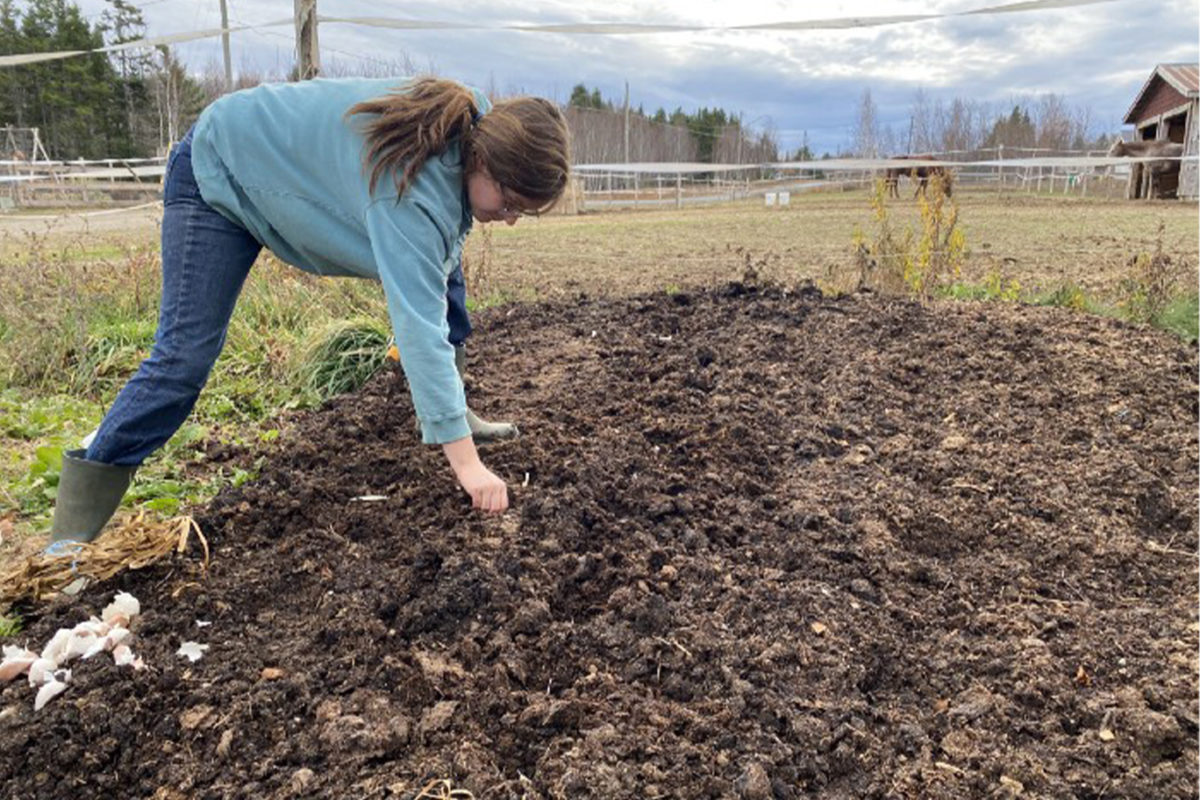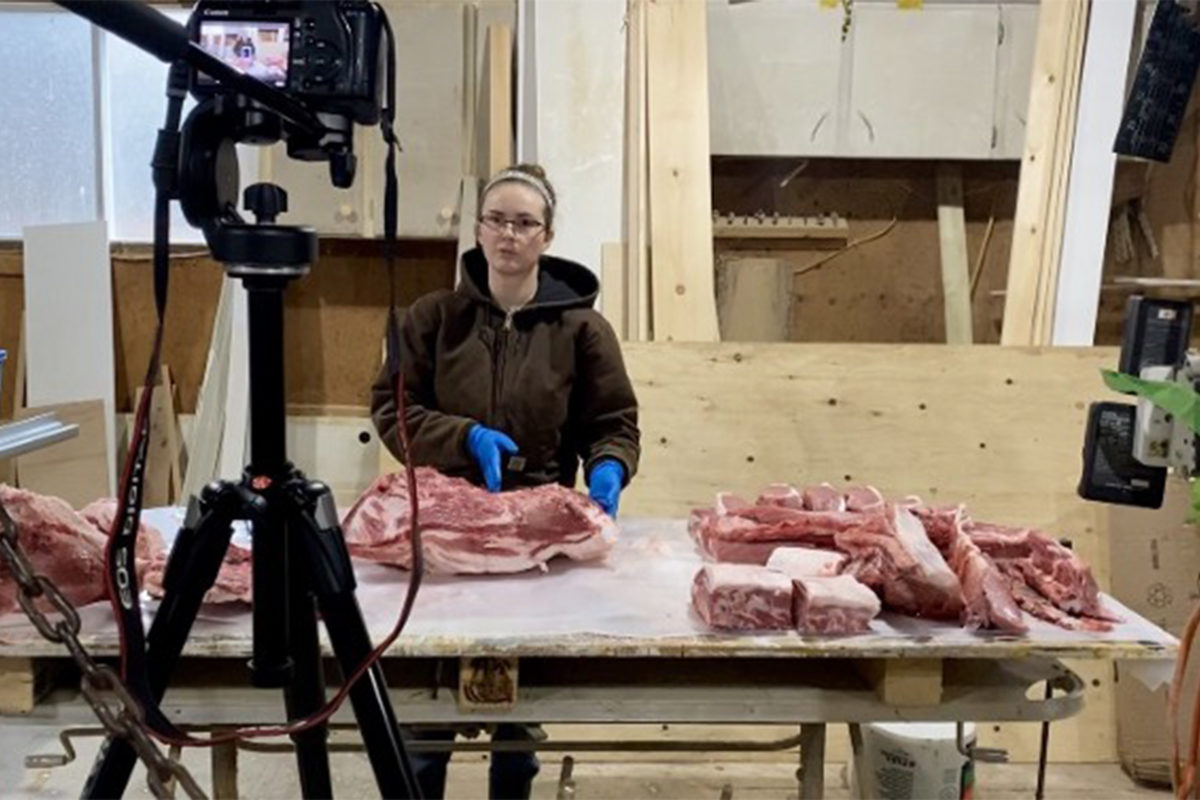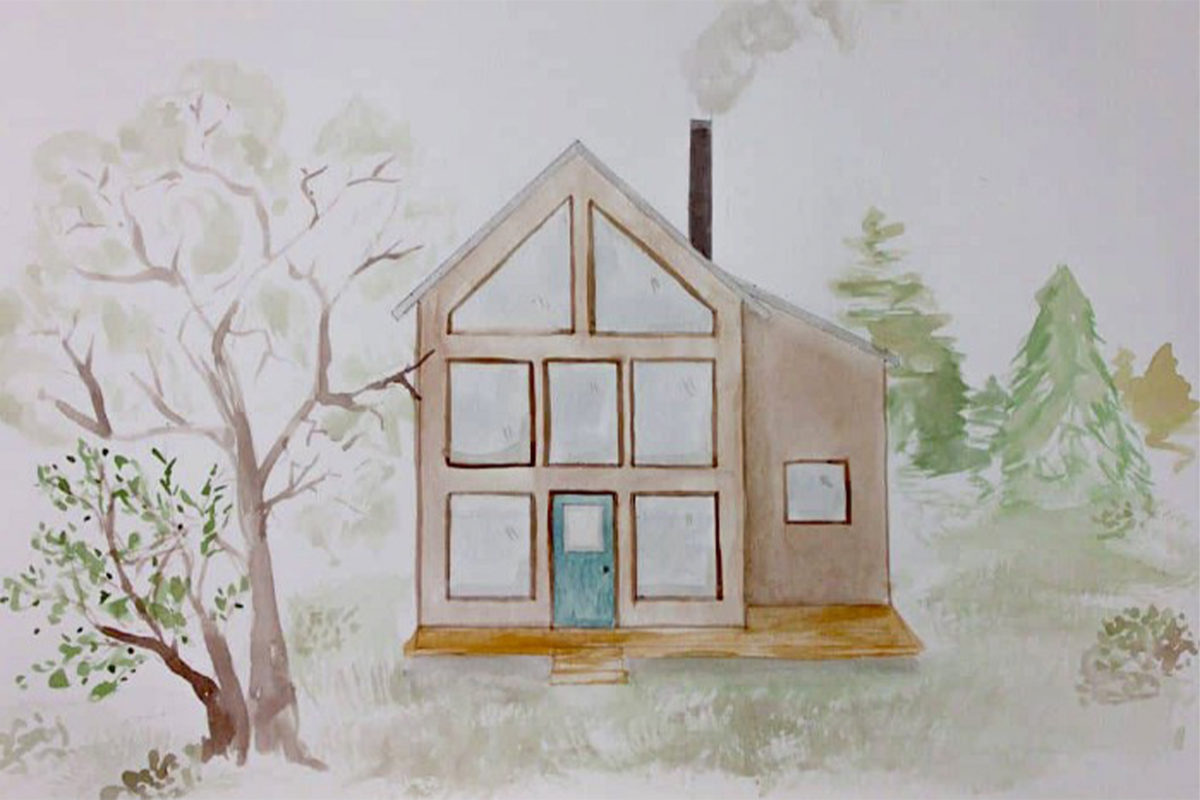
On a warm fall afternoon, Maggie Gilmore is in her grandfather’s work shed butchering a pig. She stands and stretches, surrounded by the remains of the pig, her dusty brown hair tied back and wrapped in a headband. Her glasses keep sliding down her freckled nose. She leans back in close to the table that is covered in plastic wrap. With her blue latex gloves, she reminds me of a surgeon in an operating room.
As she’s slicing through the shoulder, all the while referring to printed directions on how to properly butcher a pig, her husband Eric calls. With her hands covered in pig guts, she throws them up and says, “Do you mind answering that? It’s in the inside pocket of my jacket.”
I ruffle through her jacket and realize her phone is actually in her back-jean pocket, we both start laughing. I answer the call and press the speaker button.
“Hey darling,” he says.
He tells her about plans for the following Friday. She tells him how well things are going with the pig. He tells her he will be back after supper to help finish the job. She informs me that the temperature must be cold, so the meat won’t go bad and that night is supposed to warm up, so they have to finish. He asks if there is anything in town she needed, for supper specifically.
“I got supper right here,” Gilmore says as she hacks a piece of meat off the shoulder and puts it to the side.
“There, that’s supper,” she says, laughing. She ended the call, turned to me and says, “We are no regular couple.”
When COVID-19 first swept into New Brunswick at the end of March, no one was prepared for what the year 2020 had in store. Toilet paper flew off the shelves, flour was hard to come by and most cleaning products were scarce. There were reports of food supply chain disruptions, job losses and small businesses shutting down.
While the world around her was turning upside down, Gilmore found her life remarkably unchanged.
“It’s affected us a lot less than most people because most of my life is on the farm,” says Gilmore, 25, who for the past two years has dedicated her life to sustainable living along with her husband of three years. She’s thankful to have her own garden and resources during a chaotic time like this.
“I only need to go into town once a month,” she says. “I try to avoid going otherwise.”

When I drive down the long rocky driveway of Gilmore’s parent’s home, up the Carlisle Road minutes outside of Fredericton’s north side, I’m greeted by two horses in the field, one of them being Gilmore’s sweet-sixteen birthday present, Rex.
In the space front of the fenced-in field are newly grown berry bushes. Past the field is a small garden grown as an add-on for there wasn’t enough room in the first one built. Past that is a fire pit and the pigpen. Straight ahead is the dirt road leading to their unfinished 600 square foot off-grid cabin.
Two barking dogs sprint out of the barn. The upstairs of the barn is where Gilmore and her husband are currently living in a one-bedroom apartment. Attached is Eric’s workshop, where Gilmore stores her food and plans on someday building a root cellar. To the right of the lot is an extended driveway to go to Gilmore’s parents’ home. I see the garden that has recently been harvested. Beside that are the chicken coops, the large coop belongs to her parents and the smaller one is Gilmore’s. She raises chickens for both laying eggs and meat.
Gilmore is an animal lover, so it is strange to see her hacking up a pig she raised for six months.
“We know these pigs had a very good life compared to most pigs. Even though it’s hard to kill your own animals, it’s way better for the environment and for them.”
In university, she learned how bad the factory meat industry is for the environment and for the animals. She assures me that she never wants to be a vegetarian, so this is the best way for them to get their meat.
While she’s explaining to me the process and back story of the pig, she is also telling it to a camera standing on a tripod. Gilmore is filming this for her blog, backtothelandliving.com. It consists of three topics: farmhouse food, homesteading and handmade. She also posts on Pinterest and YouTube, in hopes of attracting people to her blog.

“People think we’re insane. A blog is something that people over 30 seem to see as a hobby and not a job, but I’m not looking for a job, I’m trying to make my own job here,” she says.
She’s surprised by the number of younger people who think what she’s doing is “so amazing.”
Gilmore graduated from the University of New Brunswick in 2017 with a degree in environmental resource management. She and Eric got married the following September. A day later they fled West, stopping in each province along their travels as their honeymoon.
They arrived in High River, just south of Calgary, and lived there for a year in a basement apartment.
“We thought we’d like to experience living somewhere else at some point in our life and it was easiest to go when we had no commitments,” says Gilmore.

They returned to N.B., moved into the apartment in the barn and gradually started their sustainable living lifestyle. She got a contract job at UNB as a sustainability officer but didn’t enjoy a 9 to 5 office job. After months of consideration, she decided to quit her job.
Gilmore started looking for ways she could make money from home, ultimately leading her to blogging.
“I really love homesteading stuff, I love animals, I love making crafts and a blog is sort of artsy and I do enjoy art and visual stuff, I don’t mind technology and I love photography. Blogging combines all of those things.”
It’s been a little over a year now and she has yet to make money but does not plan on giving up.
“I really do believe it’s going to work.”
In the past month, her subscribers on YouTube grew from 200 to 400, leaving Gilmore hopeful. But her journey towards a blogging career has only begun.
When the pandemic struck, Eric was laid off from his cabinet-making company. He decided to start his own carpentry business and has been doing so for a couple of months now. Gilmore says he’s been doing well. With that income and her horseback riding lessons, they’ve been able to stay afloat. She almost feels things closing down due to COVID-19 has been a good thing for them. If it never happened her husband may not have started his own company.
“If we ever wanted to take a risk, now was the time … because we have no mortgage, no debt and no children,” she says.
Gilmore and her husband produce as much of their own food as they possibly can. They buy locally what they can’t produce.
“I rather buy locally,” she says. “It’s way better for the environment because it’s not trucked anywhere and it’s better for me.”
They realize that it’s impossible for them to be 100 per cent self-sufficient because there are things they aren’t able to produce like flour, gas, propane and sugar. Each year they add on new things to try. This year was the raising and butchering of a pig. Sometime soon, it will be bees.
“We don’t have bees for honey but that is something we’d like to do someday,” she says.
Gilmore calls herself a homesteader, for she grows her own produce, stores and cans her food for the year, raises animals for their production, works from home, will soon be living in an off-grid cabin in the middle of the woods and tries making most things by hand.
“Meat’s never going to taste so good,” she says. “We’ve put so much effort into this. We raised them, we gutted them, we butchered them.”
This was their first time owning a pig. Normally they would have just gone to a local market to buy some meat. After watching a man from their church, who’s been raising and butchering pigs his whole life, they decided to give it a go. Now they will have enough pork for the year.
The one fallout from the pandemic that has reached them is the price of lumber.
“The price of wood like tripled, it’s insane. Some people say it’s because a lot of people quit going to work because they could get the EI thing. They would rather stay home than [go] in the woods. So, they had less wood supplies, and the price went up.”
This has affected the cost of their off-grid cabin. They are still managing to stay within their budget of $40,000.

“We had the classic save your money for down payment and buy a house thing, but we decided we did not want to be in debt for 25 plus years.”
They started organizing the plans for their home last winter, began building in August and will continue next summer. They hope to be living in their home by next Christmas.
As many supplies ran short due to COVID-19, Gilmore found seeds and canning supplies were hard to come by. People were worried about the unknown and looked to growing their own food.
“I think it’s good for people to do these things, that’s what my blog promotes. It’s good for the environment and it’s good for them.”
But these are things she relies on for her way of living. Luckily, she bought her seeds early this year, expecting a wave of spontaneous gardeners to appear. A lady from their church gave her all of her canning supplies as she no longer needed them. Although it may seem like a big worry for a homesteader, the shortage of these supplies did not have much effect on her.
Gilmore tries to make posts weekly but with the building of her home that has become more difficult. Now that winter is approaching and they can no longer do construction, she hopes to be back on track and works towards her goal of earning money for her blog.
“If I was posting more often, I know I could be making money.”
It’s almost 2 p.m. and Gilmore has some barn chores to do, so she informs me that this will be the last cut for now. As she’s finishing up, I ask her what young animal-loving Maggie would think of this, “I’d be crying,” she says, laughing. She recalls the time her father had taken her fishing and she did not realize the fish were going to die.
“I couldn’t stop crying because I did not realize we were going to be killing fish in this fishing opportunity. I thought we’d be looking at fish, not murdering fish,” she says to me, adding that butchering these pigs was a trial run.
“It’s sad, the first five minutes after killing was hard.”
Gilmore’s father offered to kill the pig and he felt it was very difficult, physically and emotionally. In order to kill a pig, you must shoot them in the head three times and then slit its throat. That process cannot be easy.
“Since we raised it, it was difficult to watch,” she says.
Gilmore does not know if anyone would be willing to do it for them next year. They would like to grow a couple more next year to sell.
“We just need to find someone to kill them.”
We pack our things in the shed, getting ready to leave. Gilmore knows I have a dog from previous conversations and asks if he’d like a bone. I told her how much he loves bones and how fast he chews through them. She looks over in the bag of chopped-up bones and nonedible meat bits, picks a piece up and examines it closely. Noticing some skin on it, she slivers it off and then wraps it in a piece of the plastic wrap used to cover the table. I thank her and tell her to enjoy her fresh pork chops that she’ll be eating tonight.
As I back out of the very long downhill driveway, I wave goodbye. I never imagined leaving an interview with a piece of a pig’s leg on my car floor, however, as Gilmore reminded me earlier, they are no regular couple and these are no ordinary times.
